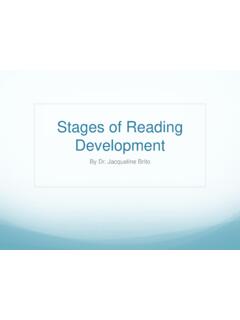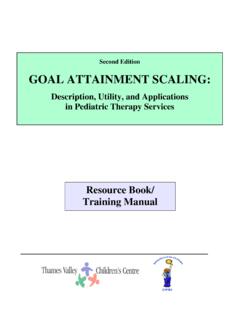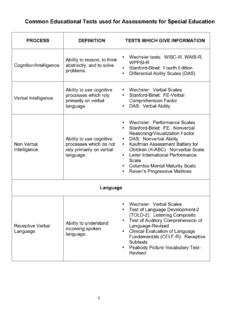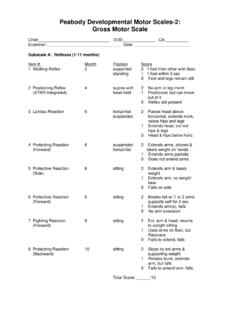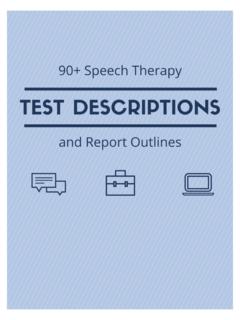Transcription of Physical Therapy Considerations for Children with Down ...
1 Physical Therapy Considerations for Children with Down syndromeNADS Conference August 11, 2018 Joanna McFaul, PT, DPT, PCS Big PictureThe focusof Physical Therapy is develop a body that is fit and functional for a lifetime Reducing unhelpful compensations Encouraging Participation Possiblyaccelerating the rate of milestonesSettings for Physical Therapy Neonatal Intensive Care Unit Early Intervention School-based Inpatient hospital or rehab hospital (acute care) Outpatient Wellness groups Specialty Clinics When does my child need PT?
2 When they are working towards achieving a new gross motor skill or participating in a sport When their gross motor limitations are impacting their safety or participation in school, recess or in gym classAfter an orthopedic surgery When musculoskeletal pain issues arise Musculoskeletal FactorsLow Muscle Tone (hypotonia)-a low level of muscle contraction during a resting state; limited resistance to passive movement of a muscleAffects all areas of the body, including oral motor skills and intestinal motilityMusculoskeletal Factors Ligamentous Laxity (Loose ligaments)oDecreased collagen fibers Decreased Strength Delayed skeletal maturation oShort arms and legsMusculoskeletal FactorsStrength HypotoniaLigamentous Laxity hypoplasiaomuscle hypotoniaoaxial control of the trunkobody balanceocoordinationospeech disorders2.
3 Corpus Callosum sizeaffect coordination 3. Other health concerns or illnesses Underlying Causes of motor Difficulties Associated Conditions that may affect mobility Obesity Hearing and vision loss Cardiac abnormalities Decreased mobility from surgery Seizures Sleep apnea Ear infections Chronic upper respiratory problemsMotor Learning Considerations1. Reduce hands-on support when safe to avoid dependence 2. Practice new skills in new environments3. Provide visual and tactile cuesMotivation Strategies Visual SchedulesoShows the order of activities during Therapy Motivation Strategies Token ChartsoChild works for an object or activity by rewarding a desired behavior Motivation Strategies First _.
4 Then _ VisualoShows something the child prefers that they will get after completing a less preferred taskMovement Patterns Decreased kicking in infancy Wide-base of support with all activities Movement in straight planes Co-activation of muscles for stability Latent (delayed) muscular responses Require more time to learn movement as movement complexity increases (Palisano, 2001) Slowness of movement Less precise, coordinated & efficient MilestoneKids with Down syndrome(Median)Range with Down syndrome Typically Developing (Median)
5 Rolls to prone7 months5-9 months7 monthsSits unsupported10 months8-11 months7 monthsCrawls14 months9-19 months8 monthsPulls to Stand15 months8-26 months8 monthsStands Alone18 months12-38 months11 monthsWalks Alone23 months13-48 months12 monthsRuns4 years NA1 years Jumps4-5 yearsNA2 years Developed from Winters, 1997 and Pereira et al, 20136121824303f6486072 Sit87899100100100100100100 Crawl1019345371849699100 Walk141440749299100100 Run1235812254567 Jump000125185284 Probability of Achieving Gross motor Skills Palisano et al, 2001 Study of 121 Children , showing percentage of Children who reached these milestones by age in months Orthopedic Issues Green, 2008 Scoliosis (thoracogenic) (Milbrandt& Johnson, 2005) n=379 Arthropathysimilar to ArthritisoPolyarticular(in >1 joints) with subluxation, (Olson, 1990)
6 Orthopedic Issues Hip issuesoHip dislocation/dysplasia, symptomatic 2-10 years with limp, poor gait, pain, oSlipped Capital Femoral Epiphysis , Perthes 2%oProgressive hip instability after skeletal maturityOrthopedic Issues Patellofemoral (knee) Instabilityo20% instability, 4-8% dislocation Pes planus (flat feet) Osteoporosis, lower Bone Mineral Density even at young age (Center, 1998) which can lead to fractures Atlanto-Axial Instability 15-20% have subluxation, 1% is symptomatic Symptoms: oNeck pain/stiffness, cervical deformity, headache, extremity pain, deterioration of gait, spasticity, hemiparesis, hyperreflexia, bowel/bladder changes Could cause acute cord compression or sudden death X-Ray Screenings?
7 OAAP no longer recommendsoSpecial Olympics requires Separhiet al, 2005 and Bull 2013 Atlanto-Axial InstabilityAvoid manipulation or adjustments to cervical spine May require radiographs before anesthesia or before planned intubation (emergency intubation requires caution for neck position)Avoid football, gymnastics, trampolines, #a1 Exercise Capacity Adults with DS have lower cardiovascular capacity with lower mean peak Oxygen consumption, minute ventilation and heart rate during exercise (Pitetti, 1992) Contributing factors.
8 OLower lean body muscle massoLower muscle strengthoThyroid disordersoHypotonic muscle toneoObesityoImpaired sympathetic response to exerciseBarnhard & Connolly, 2007 Assessment Tools Test of Infant motor Performance Alberta Infant motor Scales peabody developmental motor Scales Gross motor Function Measure Pediatric Evaluation of Disability Index Timed up and Go Test (not Timed Up and Down stairs) Pediatric Balance scale Impact of ExerciseChinxiao et al, 2013 Review of 10 RCTs Four different fitness outcomes reported in studies:oBalance (4 studies)oMuscle strength and endurance (7 studies)oCardiovascular fitness (2 studies)oBody composition (3 studies)Treadmill Training in Infancy Ulrich 2001o30 subjects, RCToTT from sitting unsupported until 3 independent stepsoHome treadmill for 8 per day 5x/wk oTT group walked 101 days earlier (ave 20 mo v.)
9 24 mo)Higher intensity helps reach 6 other motor milestones and walking even 2 months before low intensity Bicycle Training Orthotics Used to improve flat feet (pes planus), improve postural stability, balance and motor skillsMost commonly used are SupraMalleolar Orthotics (SMOs) or customized foot orthotics as kids get older Results of Using SMOR andomized controlled trial of 14 kids with DS, ages yo Improvement in balance (p=.027) Improvement in gross motor skills on the standing, walking, running (p=.
10 001)and jumping (p=.0001) sections of the GMFM(Martin, 2004)OrthoticsBefore walking? Looper, Ulrich, 2010 oInfants with DS who used SMO pre-walking had lower scores on the GMFM one month after onset of walking than those who did not use SMOs No difference in onset of walking between groupsHowever, Some infants won t be able to stand without orthotics Other Interventions Hip Helpers Abdominal Binder
